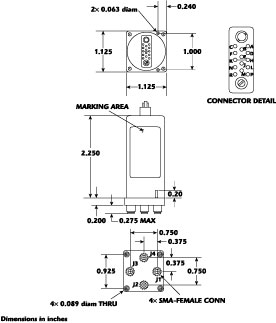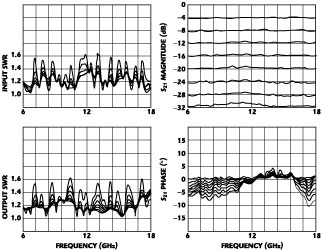Product Feature
Phase Invariant Attenuators
G.T. Microwave Inc.
Randolph, NJ
The function of a phase invariant attenuator is to change the amplitude in the processing of a microwave signal with minimal impact to the phase characteristic.
The theory of operation is that when a signal reaches its maximum attenuation, it has a bi-phase characteristic and returns to insertion loss with an equal and opposite characteristic. Therefore, the input signal is divided into two equal signals with each processed through a variable attenuator and then combined at the output. As a result, each signal, one programmed from the 0° phase state and one programmed from the 180° phase state, will cancel the errors of each other. In effect, it is two attenuators that perform a task while providing compensations to improve the overall performance. Cascading multiple phase invariant attenuators improves phase and amplitude characteristics, as well as increases dynamic attenuation range.
Simply stated, if one were to imagine a polar chart with these types of attenuators, one at 0° and one at 180°, and then calibrate them to simultaneously reach the center, they would cancel each other's errors and virtually remain constant in phase and amplitude variations vs. frequency while changing attenuation values.
The key component is a 3 dB, 90° quadrature hybrid. The input signal is processed by the first hybrid. It equally divides the amplitude and the two signals are isolated. Two hybrids are used as variable attenuators; each controls the magnitude and is capable of a 180° phase shift. The final hybrid combines the signals at the output.
In the RF design of a phase invariant attenuator, the preferred media is microstrip. Traditional hybrids are designed in stripline. Whether incorporating a stripline hybrid as part of the circuit or as a discrete component similar to hybrids for microstrip configurations, the result is that the microwave fields of propagation are excited. This creates a discontinuity within the transmission line of the device. Techniques can be employed to minimize the discontinuity, but with multiple port hybrids this event occurs directly or indirectly. To this end, changing media alters fringing fields, thus creating adverse effects and degrading performance.
|
|
|
|
Fig. 1 A single-section attenuator's independent 0° and 180° states. |
Fig. 2 Combined states of cascaded attenuator sections. |
In a very natural progression, hybrids in microstrip were developed to eliminate the discontinuities. This complements the design. In a stripline hybrid, tuning is performed between measurements because the hybrid's circuitry is not accessible. Microstrip hybrids allow access to the circuitry while being measured. This provides for a more precise tuning capability. The technique yields an overall improvement in both optimization and performance. Broadband hybrids exhibit a 3:1 bandwidth with an amplitude balance of ±0.5 dB, a phase balance of ±2°, an isolation of 25 dB min and an SWR of 1.3 max.
With the transmission problems eliminated by using a true microstrip configuration for the entire microwave circuit topology, there were other design considerations that were incorporated. The choice of a diode was an important design consideration. Using chip diodes with a ribbon lead in a shunt configuration has its drawbacks. In a high frequency broadband application, the inductance of ribbon leads adversely affects the attenuation and phase. A beam lead diode installed using a proprietary technique reduces the series inductance and provides a significant improvement in performance.
To minimize adverse effects from biasing, the biasing networks are located as far as possible from the direct signal paths. In addition, the line length between adjacent hybrids is zero for optimal broadband performance.
Even with the improvement in the microwave performance, it is the control circuitry that provides the absolute accuracy for the overall device. The control section of the phase invariant attenuator is designed as two independent 0° and 180° drivers with digital or linearized voltage controlled inputs.
The 8-bit digital model has 256 monotonic steps. The optimal performance values are stored in the driver's electronically erasable programmable read-only memory (EEPROM) ready to be commanded from the digital control input. This is accomplished by using a computer with I/O and IEEE controller cards, a proprietary program and a vector network analyzer. The computer sets the external control input for the desired attenuation then ramps the driver's 4K of resolution using an internal control input. While ramping the drivers, the vector network analyzer measures each step and sends the data to the computer via the IEEE bus. The optimal performance is mathematically calculated by the computer and the driver's EEPROMs are programmed accordingly.
|
|
|
Fig. 3 A broadband phase invariant attenuator with 32 dB of dynamic range. |
Typical performance achieved using the described techniques is shown in Figures 1 , 2 and 3 for a single-section attenuator, cascaded attenuator sections and a broadband phase invariant attenuator with 32 dB of dynamic range.
This technology is applicable to a variety of products, which include bi-phase shift keying, quadrature phase shift keying and vector modulators, and phase shifters. Models are offered with options that include digital control with up to 64K of resolution, linearization or any desired control input slope characteristic, narrowband optimized performance, temperature compensation, video filtering and sub-assembly integration.
With the new millennium upon us, modulation techniques will require technology to demand a new generation of components. They will require improved performance at lower cost. The phase invariant attenuators provide tomorrow's capability today.
G.T. Microwave Inc., Randolph, NJ (973) 361-5700, www.gtmicrowave.com.
Circle No. 303



